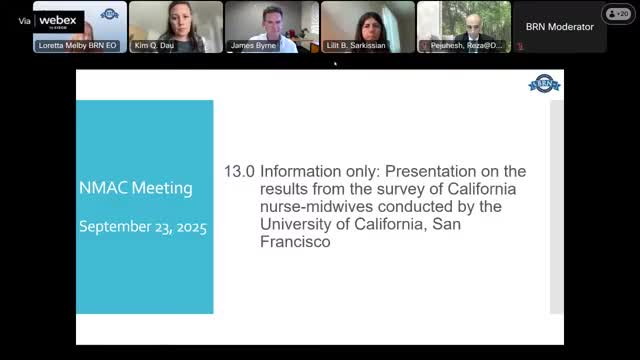California Nurse Midwives Association Supports Regulatory Updates for Accreditation and Certification Standards
September 30, 2025 | California Board of Registered Nursing, Boards and Commissions, Executive, California
This article was created by AI summarizing key points discussed. AI makes mistakes, so for full details and context, please refer to the video of the full meeting. Please report any errors so we can fix them. Report an error »

The recent Nurse Midwifery Advisory Committee meeting held by the California Board of Registered Nursing highlighted critical findings from a comprehensive workforce survey conducted by the University of California, San Francisco. The survey, which gathered responses from 700 licensed nurse midwives in California, revealed significant trends and challenges within the midwifery profession that directly impact maternal healthcare in the state.
One of the most striking findings was a 50% increase in the number of births attended by nurse midwives, rising from 8.4% in 2012 to 12.8% in 2022. However, the distribution of nurse midwives across California remains uneven, with the Greater Bay Area housing the majority. This disparity raises questions about access to midwifery care in underserved regions, particularly in areas like Los Angeles, where job opportunities for midwives are limited despite community needs.
The survey also revealed demographic trends, indicating that the average age of nurse midwives is 50.4 years, with a significant portion nearing retirement. Alarmingly, only 57.4% of respondents reported practicing to the fullest extent of their legal scope, a notable decline from 72.4% in 2017. This drop may be linked to ongoing institutional barriers despite legislative changes aimed at enhancing midwifery practice.
Education and training emerged as critical issues, with only two active nurse midwifery programs in California. The lack of clinical preceptors was identified as a significant bottleneck, limiting the ability of midwives to mentor new students. The committee discussed potential legislative solutions, including two bills currently awaiting the governor's signature that aim to establish funding for new midwifery programs and to study the sustainability of existing ones.
The meeting underscored the urgent need for policy changes to support the midwifery workforce, enhance training opportunities, and ensure equitable access to maternal care across California. As the state grapples with a maternity care crisis, the insights from this survey could inform strategies to bolster the midwifery profession and improve health outcomes for mothers and infants alike.
One of the most striking findings was a 50% increase in the number of births attended by nurse midwives, rising from 8.4% in 2012 to 12.8% in 2022. However, the distribution of nurse midwives across California remains uneven, with the Greater Bay Area housing the majority. This disparity raises questions about access to midwifery care in underserved regions, particularly in areas like Los Angeles, where job opportunities for midwives are limited despite community needs.
The survey also revealed demographic trends, indicating that the average age of nurse midwives is 50.4 years, with a significant portion nearing retirement. Alarmingly, only 57.4% of respondents reported practicing to the fullest extent of their legal scope, a notable decline from 72.4% in 2017. This drop may be linked to ongoing institutional barriers despite legislative changes aimed at enhancing midwifery practice.
Education and training emerged as critical issues, with only two active nurse midwifery programs in California. The lack of clinical preceptors was identified as a significant bottleneck, limiting the ability of midwives to mentor new students. The committee discussed potential legislative solutions, including two bills currently awaiting the governor's signature that aim to establish funding for new midwifery programs and to study the sustainability of existing ones.
The meeting underscored the urgent need for policy changes to support the midwifery workforce, enhance training opportunities, and ensure equitable access to maternal care across California. As the state grapples with a maternity care crisis, the insights from this survey could inform strategies to bolster the midwifery profession and improve health outcomes for mothers and infants alike.
View full meeting
This article is based on a recent meeting—watch the full video and explore the complete transcript for deeper insights into the discussion.
View full meeting
